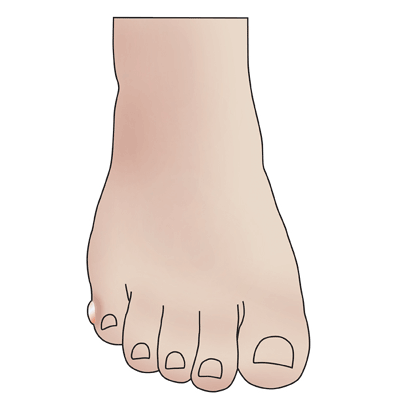Foot Blister and Toe Blister Treatment, Symptoms, Causes and Prevention
What is a Foot Blister?
A blister on your toe or foot is a collection of fluid underneath the top layer of the skin (the epidermis).
It is a defense mechanism, or "natural bandage", created by the body to help repair damaged skin.
The picture shows what a blister on pinky toe can look like.

Symptoms
One or more bubble-like areas of skin filled with clear fluid, ranging in size from a pinpoint to several inches. Some blisters on feet are accompanied by redness, itching and pain. Others may contain blood.
Causes
What causes foot blisters?
Friction is the most common cause of a blister on the foot or toes. When skin constantly rubs against another surface, tearing the upper layers of the skin and filling the injured area with fluid. Big toes, heels, sides of the feet and pinky toe blisters are the most frequent affected areas.
Common causes of blisters on feet from shoes or hosiery occur because they do not fit properly. Other causes of blisters include burns, allergic reactions, infections or autoimmune disorders.
Prevention
How to prevent blisters on feet?
To prevent a blister on your foot, do one or more of the following:
- Wear properly fitting hosiery and shoes, making sure to avoid ones that are too tight or too loose.
- Inspect the inside of hosiery and shoes for seams or worn areas that might produce extra friction.
- Cover friction-prone areas with a protective barrier, such as padding, powder or moisturizer.
- Wear extra protective or double-layered socks to help absorb friction within their fabric.
- Keep feet cool and dry. Be sure to change hosiery or shoes that have absorbed excessive amounts of moisture, such as perspiration or water.
Treatment
Should you pop a foot blister?
Ideally, you should not pop a toe or foot blister.
How to heal foot blisters?
When the wound is left intact, the fluid sealed inside the foot blister will soothe the bottom layer of the damaged skin. This will keep it moist while the area heals naturally. In addition, a closed wound is less likely to get infected.
How to properly treat a foot blister or a blister on toe:
- Wash the affected area surrounding the blister with water and a disinfecting soap. If the blister is popped, do not remove the broken skin.
- Cut a hole in a piece of protective padding such as moleskin or felt, just a little larger than the foot blister. This helps cushion the injured area from additional friction or pressure.
- Gently cover the blister with protective padding. Make sure that any adhesive affixes to the healthy skin around the wound and not directly on the blistered skin.
- If the foot blister is open, apply antibiotic ointment over the damaged skin and cover it with a piece of sterile gauze.
- At least once a day, remove the dressing carefully and inspect the wound. If the foot blister shows no signs of infection, repeat the above steps with a new dressing.
Severe Foot Blister Treatment:
If the wound becomes additionally painful, reddened, secretes colored pus, develops yellow crusting or does not show signs of healing after a few days, consult a medical professional for additional advice.
Links to recommended PediFix® Products:





